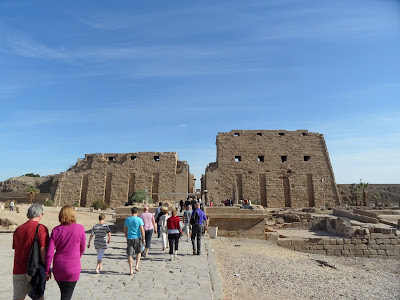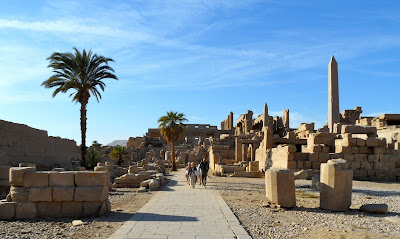Karnak Temple, Luxor Temple, and the Market Bazaar
Early morning came. I was impatient to get back up onto the deck and taste the sweet morning air and for some reason the boat had dropped it's speed to a crawl. We were back at the
Edfu Locks, following another cruise ship and waiting our turn.
When we passed this before, it was floodlit by powerful lights sending strong beams deep into the night air, but now it was a fine, clear morning.
Once again, the vendors who were most eager to make a few pennies were out with large rugs and sofa throws spread between their outstretched arms. As we entered the lock we were safely out of reach but they knew the trick; our large boat was manoeuvred gently into the narrow passageway with little more than a couple of feet each side, and before their widening eyes sank slowly as the water was pumped away, delivering us gently into the clutches of the men. I put away the camera and left the deck briefly to the few other passengers that had ventured out at 6am.
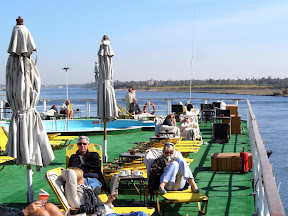 |  |
Free of the sellers, we spent a pleasant morning moving up with the current of the Nile. The morning sun was warm and not too bright, and quickly heated the deck, burning away the mists on the water to reveal the familiar shoreside views; marred only slightly by the lead boat which had drifted too close to the side and appeared to have run aground as, when we passed it there was some frantic propellering in forwards and reverse gear, which was doing little more than spinning the poor ship about it's grounded point. Putting out of our heads the thought of a similar fate, we headed down for some breakfast and waddling back upstairs we found the rare
towelsnake on our beds. By the time we had settled our food we were watching the boats pass us as we entered Luxor harbour, from our bay window.
Hani gathered us up and we headed up the gangway and past the sellers who seemed to have been waiting for us since the last time we were here. Coaches were waiting to take us across the city to Karnak Temple, the first of the two great temples we would be visiting. Our coach passed Luxor temple along the seafront and then headed inland, winding it's way through what must have been every back street through some semi-acknowledged one-way system before finally hitting a stride along the straights and heading to it's destination, deftly sweeping through chicane barriers and losing as little time as possible on the speed bumps. Every now and then, a house or wall would flash by with
graffiti or stencil art, invariably telling Mubarak where he could stick his regime.
When we hit Karnak temple, the politics disappeared and was replaced with carefree tourism for a while. The sun was at it's height but the open areas were fresh and a little breezy. We moved as a group through the mini-museum and out across the pleasantly tiled west entrance court as the giant pylons of Karnak rose from the ground ahead of us.
The first thing you notice when you get close is the line of semi-ruined Sphynx statues, each raised on a plinth and pointed towards the visitor on either side as they make their way to the entrance. Those that have them are topped with the heads of rams, rather than human heads, as a symbol of
Amun himself. Karnak temple is a huge complex - larger in landmass even than the pyramids at Giza, though much of the original layout is in ruin. The entrance we were going through took us into the
Amun-Re Precinct, a relatively new addition to the complex and thus more complete than others. In fact, Amun-Re is the only section open to the public, representing a small proportion of the total area.
Hani gestured towards the south side of the complex and pointed into the distance. Past the trees, roads, churches, mosques and assorted dusty buildings that lay beyond was the tip of the ruins at Luxor pointing out of the haze. From the ruined south entrance, back a mile or so to that other temple, the Sphynx Avenue once extended, linking the two. And below the dusty roads and layer upon layer of earth, rubbish and stone, it is thought to still stand, largely intact.
Work is progressing to uncover the avenue and restore the hundreds of statues to their ruined best and this has been
largely completed, although there remains a tricky issue about the remaining sections. Several churches and mosques are situated on top of the avenue, and Egyptian policy is that they cannot be destroyed, and any movement must be universally agreed by all parties. This is the main reason (other than regime change and a general lack of money) that the work is still not complete.
Amun-Re alone was large enough to command a good viewing. Entering through the massive
pylons, symbolically representing the 'feet' of the temple god, we saw a much ruined - though partially restored - line of columns that would originally have held up the stone roof. One pillar had been completely restored, and showed the fluted lotus
capital - the topmost decorative stone - to give a feeling of the common themes of the architectural artistry.
As work to restore the ruined temple progressed from the turn of the 20th century onwards, not only the stone structures were retained. Behind one of the entrance pylons, in the shade from the sun stood a pile of earth and rocks, scaling almost as high as the pylon itself. Far from being wrecked, the top of the pylon was missing because it had not been finished - as it's construction coincided with the end of the period of power and prosperity of the Egyptian gods. The pile of earth buttressed the semi-complete structure and served to explain how the pylons were built. On the way up, successive layers of earth were built up in tracks to allow huge stones to be lifted to the build level until the structure was complete. Then, as the earth was taken away, the exposed stone was carved to create the murals.
Karnak's next section was the biggest draw. The
Great Hypostyle Hall comprises sixteen rows of huge columns, holding up the now largely missing roof many feet above. Each column is intricately carved with the proclamations of high-ranking kings, who after
Seti's original construction had murals depicting their power and deeds carved into any spare section of wall. Walking into the sun-dappled room is a humbling experience in terms of the scale and effort that these ancients managed with just the grunt power of oppressed slavery to get the job done. The columns had been extensively restored, and in order to remain brutally honest with the viewers of their restoration, UNESCO covered the damaged parts of each column up with plain, modern plaster without attempting to copy the original style, so you could see which bits were authentic and which was a repair.
Beyond the relative order of the hall lay an inner area, made up of more ruinous structures and small theatres and rooms. Huge and imposing piles of stone blocks shut out the sun above and looked in an ominous state of near collapse. In among this random placing of loose jigsaw pieces sprouted large stone obelisks, their relative good condition making them appear to be new growth rising from the ruins of the old.
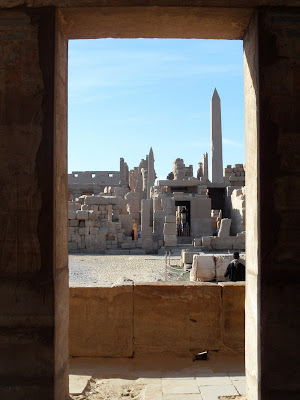 |  |
Our cameras were filled with geometric structures singed by the hot sun, and as Ms. Plants had had enough, she beckoned me back to the coach. As usual, Hani's whistle-stop touring meant we couldn't dawdle too much. As she quickened her pace I took a few final snaps and, on the way back across the entrance, passed a handful of tourist shops. Always wanting a nosey but with a hurried sense of not wanting to walk back, I perused the wares of one whose owner assured me of no pressure to buy. An assorted collection of polished black figurines covered a carpet under the shade of an erected canopy. Pharaonic Gods mixed with sacred animals, pyramids and miniature obelisks were creatively mixed together, carefully arranged with the smallest at the front. An Ibis statue, jet black and delicately carved, it's stick thin legs and slender beak threatening to break off at the slightest touch took my eye in particular, but the widening eyes of the attentive assistant and the thought of the revving coach engine and an impatient Hani (not to mention the other half) wrenched me away from any potential buying opportunity.
For the small coach ride to
Luxor Temple, the thought of that statue on my mantelpiece simmered away, but any regrets on not shelling out there and then were tempered with the knowledge that these statues were ten a penny and for sale everywhere we had been up until now. Another one was sure to surface.
The coach pulled into a gravelled area and Hani took us down through some bushes where the other end of the Sphynx avenue greeted us at the entrance to the temple. The straight road extended far into the distance before the first modern obstacle brought the run to a halt; a large Coptic church jutting out halfway into the walkway.
Hani gathered us at the entrance. A pair of pylons were joined two statues of Ramesses II. A single obelisk stood in front of one of them, and a plinth for a second sat close by. In the 19th Century, the Egyptian governor gave it away to the visiting Frenchies, who duly gave them a clock in return, which as with many examples of French engineering, stopped working in less than a year.. It stands impotently in a once-ornate clocktower in the
Alabaster Mosque in Cairo, slowly rusting.
The statues were more interesting than first assumed; Ramesses II had his figure plastered all over the country in murals and statues, but these ones were slightly different. As you entered the temple and saw them in profile it was clear that the rock from which one was hewn had an entirely different purpose. A partial obelisk ran down the back of the right statue, suggesting that it broke as it was being carved and the huge rock was re-appropriated.
The Sphynx Avenue wasn't the only example of an ancient monument built over with modern structures; Luxor temple itself actually acts as the foundation to the
Abu Haggag mosque, whose white and terracotta upper floors stare down at you as you enter. Originally built as a Christian church, the builders used the innocuous stones jutting out of the hill as their foundation in the 12th Century, not realising until several hundred years afterwards that there was an entire temple underneath all that earth. Initial attempts to have the mosque moved were resisted due to it's religiously intrinsic placing, and the merged structures remain to this day.
By now the sun was getting low in the sky, which made for some beautiful golden colourings of the walls and a pleasant cooling of the air. The shadows lengthened as we headed further inside towards the sanctum, through beautiful open courtyards lined with papyrus-capital columns. As we got further in, evidence of Romanic changes cropped up. Alexander the great claimed the temple as his own and built a chapel, complete with a symbolic stone tablet announcing peace in the area. Further still, the Roman empire stamped their authority, using the image of a carved stone eagle to represent their might and forced takeover of the temple, which still bears faint fragments of Roman murals, painted onto plaster renderings over the original Pharaonic ones.
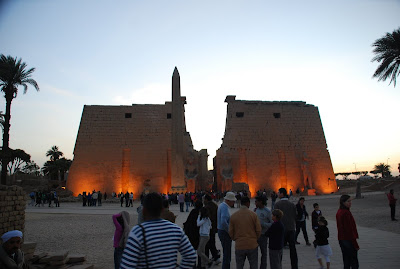 |
We wandered around for a while in the dying sun as the lights began to come on. The temple was bathed in a blood-red glow as we left for the bus once more. We were back at the ship before we knew it and more than a little hungry. Our towels had morphed into a
huge lotus blossom when we got back.
We had a bit of a think after the food and decided that it was too early just to kip on some full stomachs. The paper map of Luxor we had lying around since day one mentioned a tourist area full of places to see and shop, and since I still had a bit of Ibis-searching left in me, we headed off by foot.
As is usual, we were mobbed as we rounded the side of Luxor Temple. Young men in charge of horse and carts in varying states of repair shouted over, asking us where we wanted to go, in the hope of getting us to board. It was annoying but these were desperate times and the tourism had almost dried up. We carried on as the map suggested it was just around the corner.
The middle of Luxor was alive with lights and cars and noises, and the call to prayer of the nearby mosques had begun. You might expect everyone to drop what they were doing and pray, but the roads stayed busy, and the market bazaar, when we got to it, was heaving.
Ah, a proper market street, and for the first time we had let ourselves of Hani's leash and were walking amongst the locals on our own. And boy did we know it. The market bazaar is a long, narrow covered street, branching off every now and again, and stuffed to the gills with shops on both sides, the wares spilling out of the shops and into the street. And our western faces and clothes did not go unnoticed. The other half was wearing a 'Canada' sweater, and our language was tested at every turn with calls of 'Hey, Canada Dry'. If we turned around to the caller without thinking, they knew they had an English speaker amongst them, and would be in with a shot of taking our money.
Making our way through the street was actually pretty tough going with this happening every five seconds or so. At one point, we exchanged understanding glances with an equally harangued pair of tourists coming the other way. We were actually glad of the odd time when we were invited in by a shop owner, containing his enthusiasm enough to assure us of 'no hassle', which bought us a few moments of peace, due to the unspoken agreement between the shopkeepers that they don't nick each others' custom. To my surprise, my searches in this most bountiful of places didn't turn up a single Ibis statue of any merit, being only the (in my mind) ugly looking flattened ones, despite having perused a good dozen shops and stalls groaning with figures of all shapes and sizes.
Eventually, we took a chance in a spice shop; we both wanted to get some authentic Egyptian herbs and spices to bring back to the west for cooking. If you go shopping in Egypt, this is certainly one of the places to go - the colourful sights and smells of the many exotic spices mix well with the hospitality, and I made sure to get some of the sweet tea that arrived on a tray carried by an enthusiastic young lad shortly after we entered. The shelves were groaning with ready-packed spices, but we knew better than to go for those, as they could have been there a lifetime. Instead we bought cumin, coriander, chilli and paprika pods from the bulk bins, and Ms. Plants, who was in her element, bartered the price down from an initially hefty number down to something more manageable by the use of stern talking and a withering stare. I was in awe.
Striding out into the meleé once more we turned back and made our way slowly through and back to the boat.





